Welcome to the Aftermath!
Link to play: AFTERMATH (https://jihongni.itch.io/aftermath)
Premise:
Aftermath sets the scene as you are a young adult/ teenager who’s just woken up in a dungeon of some faraway empire. Along the way you meet a mysterious child who at many points questions you if they are someone worth saving–or if they would be a hindrance. As you navigate to escape the dungeon, you are challenged again and again on your morality as the dangers rise. The plot will unfold through a series of interactions and by the end of it, you’ll get a better sense of the moral greyness of the world and just how little you know before you make a decision.
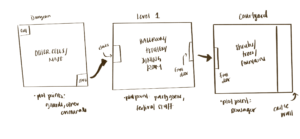
*basic map*
Overview:
Aftermath uses Twine to construct this world. As an interactive, branching fiction, Aftermath allows the players to decide their fate and how their decisions will impact their fate. This game teaches players ethical dilemmas and how these situations are impacted by the context of the situations you are in. It also shows the unpredictability of life and how sometimes decisions you make at a certain moment might end up being better or worse than you originally thought. Aftermath is a sinister game set in a dystopian world, where empires still rule the world and evil that lurks in the darkness.
Initial Version:
The initial version of Aftermath was sketched on a notebook with loose lines connecting things together. The premise of the world was connected by transitional events and the conclusions weren’t as polished.
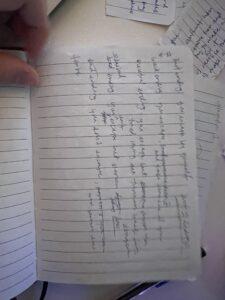
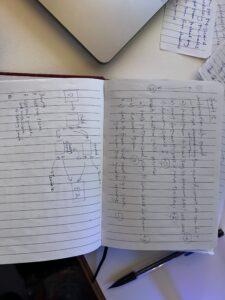
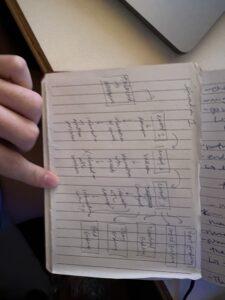
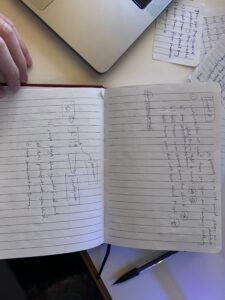
Things that were included:
- The initial exposition of the main player in the cell and then finding a child
- The map: dungeon, ballroom, and courtyard
- Interactions with the guard, partygoers/staff, and the Empress
- Conclusions or “ending” the players can land on
The main plot points were established at the beginning as they were location-based, with one being in each space. However, as interactions had many outcomes, there were times when I had to sacrifice some decisions for future iterations for the sake of a “first play through.”
The conclusions were divided into best, good, neutral, bad, and horrible endings and the way we calculated what ending the players go to was dependent on the choices they made. So each choice has a point value assigned to it and we would add or subtract from the total depending on what choice. Initially, each decision’s point value was determined by the ethical-ness of the choice, however, I came into the issue of how can one evaluate and assign numerical values to something so situational and dependent on the person and situation. Therefore, before playtesting, I got rid of the scale and point system entirely to reduce confusion.
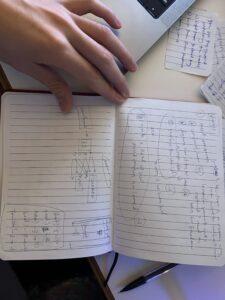
*image on the point system*
PLAYTESTS
Playtest 1: Michael and Shana (In-Class)
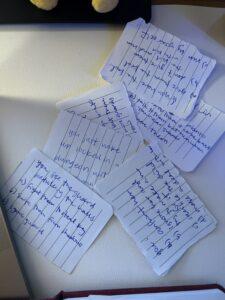
*image of the paper prototype used*
*note: no pictures of players playing since I was busy interacting with player(s)*
Feedback:
- Game evokes a chase feeling
- Wonders if there is a path where you don’t go back for the child, “Path of Non-Engaging”
- Incentive of the story: why are you trying to save this child
- Is there an ending where they all escape?
- Make the point system known at the beginning which may influence the decisions of the players
- Punishment for actions not taken
- Moral framework or ethical dilemma vibes
- Live versus live decisions
Reflection of Feedback:
- Given this feedback from Iteration 1, I realized that there is still a sense of grounding work I need to do to immerse the players into my world fully and why they should care about this child in the dungeon. There was a lot of feedback on this being an interesting direction the game is going in terms of story but there were points of confusion when the world wasn’t fully fleshed out and there were holes in places. The point system they commented on was not implemented in this playthrough but rather explained after when players questioned the method of how the endings will be determined. This brought up the whole discussion on who gets to determine ethicality and how that even should go about being ranked.
Revisions into Playtest 2:
- Flesh out the story and world more
- Add incentive to build more investment into the characters at play
- Flesh out endings more and how one concretely reaches different endings
- Add possibilities for when you don’t take the child. Are there punishments or consequences that might occur?
Playtest 2: Shimea (In-Class)
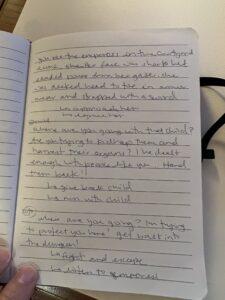
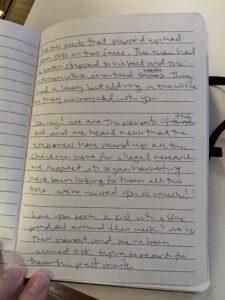
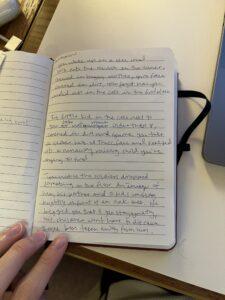
*images of the fleshed out story going into playtest 2*
*note: no pictures of players playing since I was busy interacting with player(s)*
Feedback:
- Really liked the ethical dilemma aspect; really forces the player to reckon with difficult decisions
- The story is very thrilling, lots of twists and turns along the way–especially the ending
- Wanted to build more backstory into the characters so they feel more rounded
- Wanted to know what happens if we leave the child behind? It seems like the story is pushing in the direction of bringing the child along
- Knowing what ending will lead to depending on what actions the players choose
Reflection of Feedback:
- Given this feedback, I knew the story was building up well and going in the right direction. There were still a lot of mixed feelings about if the player is able to leave the child behind. Currently, in this iteration, I haven’t thought much about a positive ending that could potentially produce a non-gruesome outcome–since the original story was centered around the child. I could either get rid of the option to leave the child or create another universe where leaving the child brings a totally different outcome. I knew that players were feeling a sense of thrill when they played the game so I wanted to emphasize that and also the confusion and loop that comes with it.
Revision into Playtest 3:
- Brainstorm about the scenario if the child was left behind
- Have more concrete endings and why the main protagonist is trapped in the dungeon to begin with
- Connecting the narrative more so endings are well tied into the actions and consequences of the narrative.
Playtest 3: Kyle (In-Class)
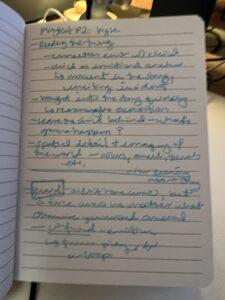
*image of notes taken during and after playtest*
*note: no pictures of players playing since I was busy interacting with player(s)*
Feedback:
- Really like the child playing the emotional crutch in the story
- Nice inciting incident that enters the story
- Question about leaving the child behind and how that might change the story
- Adding more spacial detail to really render the narrative to life
- Maybe have the guard in every situation no matter what path you take? It seems like his interaction is crucial to the interaction in the next setting
- The emotion we want to emphasize is confusion and that it’s throwing players in a loop
Reflection of Feedback:
- Really captured the emotion of confusion and the twist players feel by the ending. Although Kyle mentioned leaving the child behind, during this playable version of the game, the child left behind branch was not fully developed yet. But after explaining the ending to him, he felt like the ending really leans into this chaos. I also had a very bare-bone narrative structure so one thing that I need to add is more sensory detail to bring the players into the dystopia.
Revision into Final Version:
- Adding all the endings and connecting them together
- Beefing up the narrative structure, imagery, flow, and details
- Finishing outputting onto Twine and making it playable
Final Version:
In the final version of Aftermath, we were able to establish a lot more interactions, decision, and conclusions. While there isn’t a “happy” conclusion, most of my endings were intended to be in the realm of being morally grey. Through Aftermath, I hope to teach that there are humans that are morally grey and redemption is on the person and those around them. And that the world is filled with ethical dilemmas where decisions can be costly–even if you think it’s not. It’s to show how fickle life is and every moment can be either detrimental or not. I’ve managed to fix a lot more with the story flow, putting more options or scenarios where situations can change immediately by the choice the players make. Twine also was the perfect platform for this game since it had so many paths and twists that the wiring capabilities of the node made it easy for me to converge and diverge at any point. The playable link is at the top of this blog post.
Future Steps:
In the future, I hope to expand more into the world and implement more choices into the scenes. As I was working through this story, there were so many moments where I went, “Ah! I can add another option here,” but decided against it because that would open another branch of possibilities that I didn’t have the time to implement. I would also want to flesh out the characters even more and give them a lot more roundness and character and build up the world. A good narrative drives engagement and the overall result of the game. Adding more color, images, or better design elements could really bring this to life. Aftermath was an opportunity to expand my writing capabilities and also create a game with it.




The values that I see at play here are moral ambiguity; no matter what decisions are made, there is always something that pops up that complicates the situation that I’m in. For example, in the first play through that I was in, I was focusing on escaping with the child because I thought I was doing the right thing. After I was killed and I discovered that I actually part of an organ harvesting cult and that I was looking to get that child for their organs, I was shocked. It made the situation much more morally gray. There are many such choices presented throughout this game, where one of them seems like the ethically correct choice, but then it has implications in the opposite direction.
I think this game did a really good job of getting me to care about the topic or cause. Then I was first playing the game I was really dead set on escaping with the child, because I thought that we were both kidnapped by some malicious person or group of people. When we both were trying to escape outside, I was killed by the guards and then that’s when I found out I was a part of an organ harvesting cult. I thought the plot twist at the end of the story was great because it completely flipped my understanding of the situation. That flip is what got me to care about the idea of moral ambiguity much more.
I think that the use of the medium fit the story very well, because the many different possible choices that could be made that gave me an overall picture of what was going on in the story. I did notice that in some of the choices that I made, I would end up in the same spot, but I think that’s expected of most IFs because otherwise the amount of possible endpoints one could have becomes exponential. I think that most of the different ending game states were different enough to be captivating. In fact, I played the game over and over again because I wanted to see what happened if I did different choices. To me, it felt like the parable of the blind men and the elephant; as I experience the different endings, I get to see different peeks of the truth of what is going on as a whole.
This game definitely did have choices that were interesting and consequential to me; I was really stopping to think about whether I wanted to take the child with me, because at that point I was thinking about saving myself vs. taking responsibility to save someone else, which I think is an interesting dilemma in of itself.
One thing that I really, really enjoyed the dark twist at the end of my first playthrough, because the fact that you are locked up with a child in the next cell made it seem like you were trying to escape this prison. But the twist that you are part of an organ harvesting cult made it great because it turns your understanding of your situation upside-down. I also really like how you have many different areas to make different choices; it didn’t “feel” that linear to me, even though I ended up talking to the empress at some point or another.
That being said, I thought that some of the other endings were not as rewarding and it was not as apparent what the message was in those endings. For example, when you decide to stay with the empress without the child or the couple and you decide to stay with the empress, it’s not clear what the message is there.
I think the values of Aftermath are making decisions in a morally gray context, especially in situations where one has to decide between self-preservation and something more altruistic, and living with the consequences that play out. These values can be best located by first looking at its functional description as well as its technical constraints. I read the premise before playing, which explicitly stated that the game would pose moral challenges to me and reveal more details of the morally gray world the game is set in. The technical constraints of being made in Twine also lend itself very well to the branching/web structure of the story and the numerous different paths and combinations of options the player can take. These values are clearly reflected in the gameplay because there are numerous choices that I can choose from in the middle and towards the end of the story. I also often found myself hesitating, debating the tradeoffs between self-preserving decisions and morally correct ones.
I think the game was very compact, effective, and executed the values Ji Hong meant to convey very well. The choices kind of had me widening my eyes at some points (finding myself a little shocked that yes, I did consider throwing the child at the guard, hesitated and chose the other option, then went back and threw the child… I was curious…). I think the choices were both interesting and consequential – the branching nature of the story was done in an organized, deliberate manner so that although there were numerous paths I could take, and I felt that my choices really mattered, it did not clutter nor confuse my understanding of the story and world itself. I liked how there was some convergence between different paths as well; it was nice to see how some seemingly divergent pieces came together. I think Ji Hong really honored the medium, granted agency to the reader, and gave me a compact, interesting story to think about – loved the dark twist at the end!
One thing I liked was how I found different pieces of information about the world through different endings, so I found myself going back and playing through all the paths. One thing I would love to see more of is more description about my surroundings, what I look like, and the characters I come across. This is just a personal preference, but it really helps me immerse into a story if I connect more with a character, and I find an easy way to do this is when I find something small yet interesting to latch onto – a small quirk about their appearance, an interesting mannerism they exhibit, etc.
Thanks for creating and sharing this game! 🙂